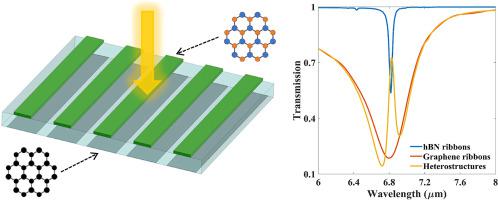Carbon ( IF 10.5 ) Pub Date : 2022-01-10 , DOI: 10.1016/j.carbon.2022.01.015
Zhaojian Zhang 1 , Junbo Yang 1, 2 , Te Du 1 , Hansi Ma 3 , Xinpeng Jiang 1

|
In this work, we theoretically investigate the polariton-induced transparency (PoIT) phenomenon based on a hetero-nanostructure that possesses hybrid two-dimensional (2D) materials. The hetero-nanostructure consists of periodic hexagonal boron nitride (hBN) and graphene nanoribbons that are separated by a dielectric spacer. Consequently, the near-field coupling between hyperbolic phonon-polaritonic resonances on hBN ribbons and localized surface plasmon resonances on graphene ribbons leads to a transparent window in the mid-infrared region, where strong phase dispersion as well as slow light effect exist. Such hybrid-polariton induced transparency is dominated by electric dipole, and possesses reciprocity. It can be passively tailored by changing structural parameters, and actively tuned by shifting graphene Fermi level. Meanwhile, it is insensitive to the incident angle within a wider range, and rotating polarization angle of the incident wave leads to the excitation of edge phonon polaritons, which enriches the adjustability of this heterostructure. Furthermore, it can serve as a mid-infrared sensor to detect surrounding refractive index change, gas concentration, and molecular fingerprints. And introducing a metal reflector can easily turn it to be a wide-angle dual-band light absorber. Finally, we investigate the near-omnidirectional PoIT and polarization-dependent PoIT in the extended bilayer metasurface. This work has potential mid-infrared multifunctional applications in low-dimensional hybrid-polaritonic nanodevices for phase manipulation, slow light, sensing, and absorption.
中文翻译:

极化子诱导的多功能混合二维材料异质纳米结构的透明性
在这项工作中,我们从理论上研究了基于具有混合二维 (2D) 材料的异质纳米结构的极化子诱导透明 (PoIT) 现象。异质纳米结构由周期性六方氮化硼 (hBN) 和石墨烯纳米带组成,它们由电介质间隔物隔开。因此,hBN 带上的双曲声子-极化子共振与石墨烯带上的局部表面等离子体共振之间的近场耦合导致在中红外区域出现透明窗口,其中存在强相位色散和慢光效应。这种混合极化子诱导的透明性以电偶极子为主,具有互易性。它可以通过改变结构参数进行被动调整,并通过改变石墨烯费米能级进行主动调整。同时,它在更宽的范围内对入射角不敏感,入射波的旋转偏振角导致边缘声子极化子的激发,丰富了这种异质结构的可调性。此外,它还可以作为中红外传感器来检测周围的折射率变化、气体浓度和分子指纹。并且引入金属反射器可以轻松将其变成广角双波段光吸收器。最后,我们研究了扩展双层超表面中的近全向 PoIT 和偏振相关 PoIT。这项工作在低维混合极化子纳米器件中具有潜在的中红外多功能应用,可用于相位操纵、慢光、传感和吸收。并且入射波的旋转极化角导致边缘声子极化子的激发,丰富了这种异质结构的可调性。此外,它还可以作为中红外传感器来检测周围的折射率变化、气体浓度和分子指纹。并且引入金属反射器可以轻松将其变成广角双波段光吸收器。最后,我们研究了扩展双层超表面中的近全向 PoIT 和偏振相关 PoIT。这项工作在低维混合极化子纳米器件中具有潜在的中红外多功能应用,可用于相位操纵、慢光、传感和吸收。并且入射波的旋转极化角导致边缘声子极化子的激发,丰富了这种异质结构的可调性。此外,它还可以作为中红外传感器来检测周围的折射率变化、气体浓度和分子指纹。并且引入金属反射器可以轻松将其变成广角双波段光吸收器。最后,我们研究了扩展双层超表面中的近全向 PoIT 和偏振相关 PoIT。这项工作在低维混合极化子纳米器件中具有潜在的中红外多功能应用,可用于相位操纵、慢光、传感和吸收。它可以作为中红外传感器来检测周围的折射率变化、气体浓度和分子指纹。并且引入金属反射器可以轻松将其变成广角双波段光吸收器。最后,我们研究了扩展双层超表面中的近全向 PoIT 和偏振相关 PoIT。这项工作在低维混合极化子纳米器件中具有潜在的中红外多功能应用,可用于相位操纵、慢光、传感和吸收。它可以作为中红外传感器来检测周围的折射率变化、气体浓度和分子指纹。并且引入金属反射器可以轻松将其变成广角双波段光吸收器。最后,我们研究了扩展双层超表面中的近全向 PoIT 和偏振相关 PoIT。这项工作在低维混合极化子纳米器件中具有潜在的中红外多功能应用,可用于相位操纵、慢光、传感和吸收。



































 京公网安备 11010802027423号
京公网安备 11010802027423号